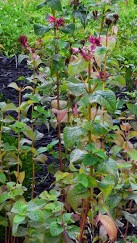 Some people clean-up their garden in the fall, some in the spring and still others do both. There are good reasons for a fall clean up, and equally good ones for a spring clean up but the best practice is to do both, focusing on different plants depending on their needs, problems, and what to off in the way of winter interest. Some plants provide winter interest and food or cover for wildlife; these are the ones to leave alone until spring. Others are prone to pests and diseases; these form a group that need a fall clean up.
Some people clean-up their garden in the fall, some in the spring and still others do both. There are good reasons for a fall clean up, and equally good ones for a spring clean up but the best practice is to do both, focusing on different plants depending on their needs, problems, and what to off in the way of winter interest. Some plants provide winter interest and food or cover for wildlife; these are the ones to leave alone until spring. Others are prone to pests and diseases; these form a group that need a fall clean up.
Disease and pest control are two very good reasons to clean up some of the plants in you garden. These are plants that are attacked by organisms that lurk in the dead plant material during the winter waiting to infect the new growth in the spring. Many fungal diseases overwinter as spores and spring to life when warm temperatures return. Similarly the grubs or eggs of pests may inhabit dead plant material or the soil during the winter and spring to life when winter retreats. By clearing away dead plant material you can remove many of them and then easily and effectively spray the ground with pesticides that will kill those still present.
This is not an argument for cleaning up all the garden in the fall. It is a suggestion for cleaning up the garden around some plants; those that are a risk of infection. Cleanup should be done in late fall when the plant has gone dormant. If a plant has an attractive seed head or fruit, leave it for winter interest or to benefit wildlife. All waste that is collected during the fall clean-up should be thrown away rather than composted as eggs and spores have a way of doing well in a compost heap thereby spreading the problems they cause when the compost is spread on the garden. There are many other plants. Here is a list of common garden plants that can benefit from a good clean up job in fall. There are many others that can benefit from winter cleanup; just think about the plants that have disease problems and they are the ones to focus upon.
Bearded Iris (Iris hybrids); fungal disease and borers
Bee balm (Monarda didyma); powdery mildew
Blackberry Lily (Iris domestica); borers; has good seed heads
Dahlia (Dalhia sp) powdery mildew
Garden Phlox (Phlox paniculata); powdery mildew, spider mites
Peony (Paeonia lactiflora); fungal disease
Rose (Rosa spp.); numerous pest and fungal problems
In addition to removing any infected plant material from these plants, also remove any annuals that have developed disease such as zinnia that is often infected with powdery mildew and hollyhock that is often infected with rust. As before, dispose of infected material in the trash not the compost heap.